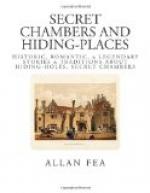[Footnote 1: There is a tradition that it was a servant of Mayne who acted as Charles I.’s executioner.]
Bradshawe Hall, in north-west Derbyshire (once the seat of the family of that name of which the notorious President was a member), has or had a concealed chamber high up in the wall of a room on the ground floor which was capable of holding three persons. Of course tradition says the “wicked judge was hidden here.”
[Illustration: ENTRANCE GATE, BRADSHAWE HALL, DERBYSHIRE]
The regicides Colonels Whalley and Goffe had many narrow escapes in America, whither they were traced. What is known as “Judge’s Cave,” in the West Rock some two miles from the town of New Haven, Conn., afforded them sanctuary. For some days they were concealed in an old house belonging to a certain Mrs. Eyers, in a secret chamber behind the wainscoting, the entrance to which was most ingeniously devised. The house was narrowly searched on May 14th, 1661, at the time they were in hiding.[1]
[Footnote 1: Stiles’s Judges, p. 64]
Upon the discovery of the Rye House Plot in 1683, suspicion falling upon one of the conspirators, William, third Lord Howard of Escrick, the Sergeant-at-Arms was despatched with a squadron of horse to his house at Knights-bridge, and after a long search he was discovered concealed in a hiding-place constructed in a chimney at the back of a tall cupboard, and the chances are that he would not have been arrested had it not been evident, by the warmth of his bed and his clothes scattered about, that he had only just risen and could not have got away unobserved, except to some concealed lurking-place. When discovered he had on no clothing beyond his shirt, so it may be imagined with what precipitate haste he had to hide himself upon the unexpected arrival of the soldiers.[1]
[Footnote 1: See Roger North’s Examen.]
Numerous other houses were searched for arms and suspicious papers, particularly in the counties of Cheshire and Lancashire, where the Duke of Monmouth was known to have many influential friends, marked enemies to the throne.[2]
[Footnote 2: See Oulton Hall MSS., Hist. MSS. Com. Rep. iii. p. 245.]
Monmouth’s lurking-place was known at Whitehall, and those who revealed it went the wrong way to work to win Court favour. Apart from the attractions of Lady Wentworth, whose companionship made the fugitive’s enforced seclusion at Toddington, in Bedfordshire, far from tedious, the mansion was desirable at that particular time on account of its hiding facilities. An anonymous letter sent to the Secretary of State failed not to point out “that vastness and intricacy that without a most diligent search it’s impossible to discover all the lurking holes in it, there being severall trap dores on the leads and in closetts, into places to which there is no other access."[1] The easy-going king had to make some external show towards an attempt to capture his erring son, therefore instructions were given with this purpose, but to a courtier and diplomatist who valued his own interests. Toddington Place, therefore, was not explored.




